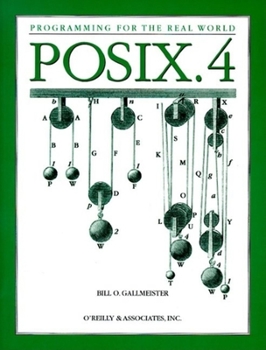POSIX.4 Programmers Guide: Programming for the Real World
What's "real-world programming"? Real-world programming (typically called real-time programming) is programming that interacts in some way with the "real world" of daily life. At one time, real-time systems were confined to very esoteric applications, like rocket guidance systems. Now, they play a role in almost every aspect of life: they control the brakes on your car, video games, automatic bank tellers -- and the disk drive in your computer. It won't be long before mundane devices like toasters and hair dryers have microprocessors built in, to say nothing of multimedia devices that haven't even been invented yet. Real-world applications are characterized by deadlines. If the brake processor in your car doesn't meet a deadline, your car doesn't stop; if your video game doesn't meet a deadline, the Klingons don't die when you shoot them; if your ATM doesn't meet a deadline, you may start looking for another bank. When you've just rear-ended another car, it's no consolation that a sudden flurry of input slowed down your brake processor, so it couldn't react quickly enough when you hit the pedal. This book covers the POSIX.4 standard for portable real-time programming. The POSIX.4 standard itself is a massive document that defines system interfaces for asynchronous I/O, scheduling, communications, and other facilities. However, this book does more than explain the standard. It provides a general introduction to real-time programming and real-time issues: the problems software faces when it needs to interact with the real world and how to solve them. And, unlike most books about standards, this one isn't just readable -- it's enjoyable If you're at all interested in real-time applications -- which include just about everything from telemetry to transaction processing -- this book will be an essential reference. Chapters include: The Basics of Real-Time: Multiple Tasks Better Coordination: Messages, Shared Memory, and Synchronization On Time: Scheduling, Time, and Memory Locking I/O for the Real World Includes programming exercises, solutions, and reference manual pages.
Format:Paperback
Language:English
ISBN:1565920740
ISBN13:9781565920743
Release Date:February 1995
Publisher:O'Reilly Media
Length:564 Pages
Weight:2.08 lbs.
Dimensions:1.3" x 7.0" x 9.1"
Customer Reviews
5 ratings
The Best
Published by Thriftbooks.com User , 22 years ago
If you know C and know UNIX, this book is for you. Simply put, he knows what he's writing about and he presents the material in a logical, methodical manner.This book was written just before the POSIX4a standard was completed, so no PThreads are covered.As long as you're not expecting PThreads coverage, you won't be disappointed. Most of the topics you need to know about mutli-threaded programming (besides PThreads) are here.
Perfectly written
Published by Thriftbooks.com User , 22 years ago
This is the best book on the subject. One can tell that the author is an expert and knows very well what he is talking about.Unlike one reviwer mentioned below - I dont think he has read any part of the book - this is not an "reasonable introduction" at all. This is an in depth handling of the topic.
Excellent guide to real-time POSIX
Published by Thriftbooks.com User , 23 years ago
The book consists of 2 parts. The 1st part is a detailed guide to the real-time POSIX programming. The 2nd part presents a reference to all POSIX real-time functions. The book also has an appendix with various sample and exercise code.All explanations in the first part are very clear and complete. Writing style resembles the best programming books (like those from K & R or R.Stevens). At the same time everything is given in a distilled manner without unnecessary water, so that you might handle the stuff surprisingly fast. The second part is less valuable since all this material can be found in UNIX man. But if to see it as just a free bonus for the 1st part it is not bad at all. In any case having printed manuals is quite useful.Sample code in the appendix is also interesting to look at.Actually I didn't notice any considerable drawbacks in the book and recommend it to everyone interested in the subject.The prerequisites are minimal. You should know C and be familiar with the basic UNIX/POSIX API (like working with files, etc.). The next reading is obvious - some book on POSIX threads (I'd recommend one by Mr. Butenhof).
Excellent reference Guide !!!!
Published by Thriftbooks.com User , 24 years ago
A very good tutorial and an excellent reference. I use the reference pages in the POSIX Programer's Guide for all of the normal library functions and I know my program will be portable. Also this book is real helpful for Most of the Unix User for Project.
Excellent reference Guide !!!!
Published by Thriftbooks.com User , 24 years ago
A very good tutorial and an excellent reference. I use the reference pages in the POSIX Programmer's Guide for all of the normal library functions and I know my program will be portable. Also this book is real helpful for Most of the Unix User for Project.





